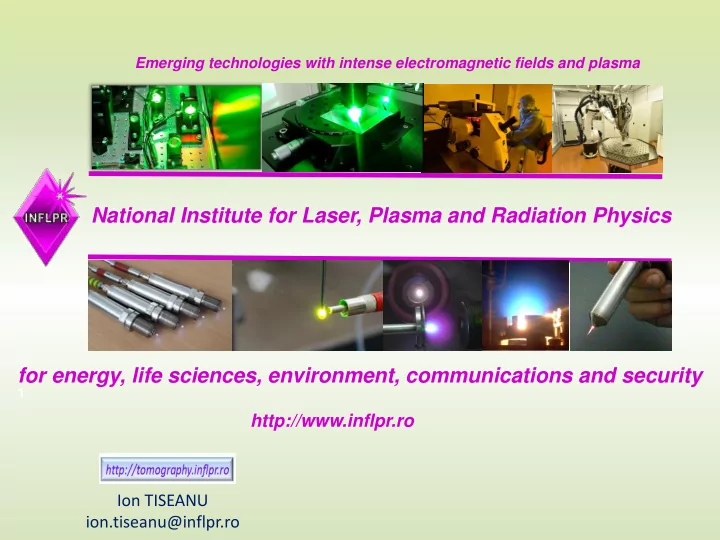

Emerging technologies with intense electromagnetic fields and plasma National Institute for Laser, Plasma and Radiation Physics for energy, life sciences, environment, communications and security 1 http://www.inflpr.ro Ion TISEANU ion.tiseanu@inflpr.ro
Motivation X-ray tomography is an imaging technique for non-invasive volumetric characterization of materials and processes It can be used in optimization of processes of waste valorization as: - recycling & resource recovery (ex. rare earths, tungsten); - pelletization of coal ash or fly ash resulted from solid waste incinerators; - production of composites from waste recycled armor materials and natural matrix (ex. volcanic ash, mortar); - characterization of waste recycled glass/textile fibers to be used in composites; - production of ultra-light composites used as building materials; - characterization of wood-plastic composites; - advanced characterization and modeling of porous materials (ex. charcoal pellets) … It could provide a unique access channel for a fully non-invasive inspection and quantitative analysis of some hazardous waste.
Applications of X-ray microtomography in microstructural analysis of materials resulting from waste processing Outline • Tomography equipment • Porosity analysis & fluid transport in porous media • Passive treatment to remediate contaminated water from acid mine drainage • Tomography analysis of fly ash pelletization process • Volumetric analysis of composite materials based on waste of metal or wood processing • Geological CO2 storage
High penetration power microfocus @ 320 kV Tomography Equipment submicron resolution
Technical data of various XCTs Type X-ray source Voxel size 3 Medical XCT- Med-XCT 140 kV rotating >(0.3 mm) systems anode tube 3 Cone beam XCT: μ XCT 225 kV μ -focus tube >(2 μ m) Rayscan 250E or v|tome|x s 240 3 Cone beam XCT: Sub- μ XCT 180 kV nanofocus >(0.4 μ m) nanotom 180 tube 3 INFLPR NanoCT Sub- μ XCT 225 kV nanofocus >(0.5 μ m) tube 3 INFLPR XCT μ XCT 225 kV μ -focus tube >(2 μ m) 3 320 kV μ -focus tube >(10 μ m) 3 Synchrotron XCT: sXCT 7 – 60 keV >(0.2 μ m) Grenoble, ESRF- ID19 NDT E Int. 2010 Oct; 43(7-3): 599 – 605. Ion Tiseanu| SOFT2018 |Giardini Naxos | 16 th to 21 st September 2018 | Page 5
X-ray microtomography Four versatile tomography units designed and constructed in INFLPR with Equipment for X-Ray microtomography analysis energies from 50 to 320 keV and sub-micron feature recognition. Wide variety of applications with samples sizes from 5 m down to 100 µm and compositional mapping 3D targets for high power laser interaction Carbon Fiber Composite X-Ray Microtomography analysis of superconductor strand & cables Medical devices 6
Berea sandstone multi-resolution analysis mini-core Φ =38 mm Φ =5 mm
Berea sandstone Φ = 5 mm - pore analysis Porosity classification by volume, area, shape, connectivity etc.
Berea sandstone Φ = 5 mm – inclusions analysis Inclusion analysis: volume, area, shape, density, composition etc.
Berea sandstone 2 mm - submicron pore analysis 3D representation of all pores ROI – magnified inner pores in 3D from reconstructed volume
Capilary presure simulation Φ =6 mm – wetting phase 2D visualisation of traped weting volume Capilary presure simulation on Φ =6 mm : weting phase 3D visualisation of weting phase traped in all volume 3D visualisation of traped wetting phase 3D visualisation of isolated pore space
Passive treatment systems designed to remediate contaminated water from acid mine drainage Four CT images of the same section: before drainage ; after 4, 8 and 12 days (passivation at ≈300 h).
Passive treatment systems designed to remediate contaminated water from acid mine drainage Rocks and mineral grain filter (such as calcite, aragonite or dolomite) calcite with size grain between 1-2 mm chalk
Passive treatment systems designed to remediate contaminated water from acid mine drainage Directional variability Grain orientation on right view sections Grain orientation on top view sections
Tomography analysis of fly ash pelletization process Core carbonation dependent on the reaction time
Tomography analysis of fly ash palletization process Core analysis Extracted core volume: 16.04% Extracted ROI with Surface determination Extracted core ROI selection surface determination on selected ROI Extracted core Extracted core volume: 32.92%
Tomography analysis of fly ash pelletization process Porosity analysis
Tomography analysis of fly ash palletization process Porosity analysis
Tomography analysis of fly ash palletization process Inclusions analysis
Composition mapping by microbeam X-ray fluorescence microXRF X-ray source X-ray detector Policapilary lens sample XYZ transition axes Standardless procedure for elemental composition
Elemental composition of fly ash pellets by microXRF Element Concentratie (wt%) Element Concentratie (wt%) Inclusions on pellet surface Fe 1,92 Fe 2,94 Cl 8,54 Cl 9,16 K 5,57 K 6,18 Ca 76,11 Ca 73,25 Cu 0,45 Cu 0,34 Zn 3,23 Zn 4 Pb 0,65 Pb 1,03 Ti 2,74 Ti 2,26 Br 0,79 Br 0,83
Volumetric analysis of waste based composite materials volcanic ash & metallic insertions Composite material made by vulcanic ash (matrix) and metallic swarf (insertions) Selected ROI Total volume of metalic insertions from selected ROI
Volumetric analysis of waste based composite material foam matrix & wood fibers Space resolution 30 µm/voxel Top: wood to matrix 8.25% Bottom: wood to matrix 7.0 %
Geological CO 2 storage Before CO 2 injection After CO 2 injection 5 4 4 6 5 1 3 3 2 5 CO2-rich acid brine will likely 4 promote the dissolution of carbonate minerals (calcite) 1 6 and aluminosilicates (microcline). 3 These coupled dissolution 2 The reservoir rocks are composed of and precipitation reactions limestone (calcite) and sandstone (66 may induce changes in wt.% calcite, 28 wt.% quartz and 6 porosity and pore structure wt.% microcline) of the repository rocks
Recommend
More recommend